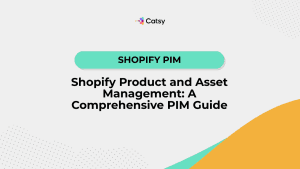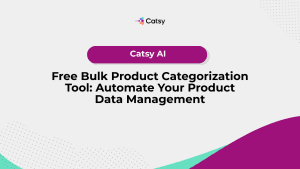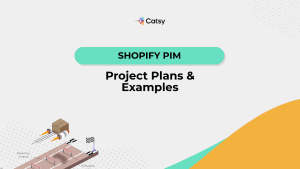What is PDM? Its Importance and Impact on Brands

- PDM consolidates product data related to design and engineering specifications.
- The centralized hub facilitates organization-wide collaboration, the basis for successful product development.
- Brands can implement PDM in collaboration with PLM and PIM to create a robust industrial marketing strategy.
In this Article
If you work in an industrial setting, you likely are often overwhelmed with product details. Like a circus performer, you find yourself juggling technical specifications, designs, and revisions across teams. As such, orderly and accurate product information feels like a challenge you can never solve.
However, this scenario may not sound familiar to those who have discovered product data management (PDM). PDM may sound like another tedious acronym to learn in the manufacturing world, but when adequately leveraged, it is a powerful ally waiting in the wings!
But what is a PDM? How does it revolutionize your workflow and increase teams’ productivity, including yourself? Is it another shiny new tool to complicate the industrial marketing tech stack?
You likely have more questions, but be sure that they won’t be around by the time you read to the end. This guide aims to make PDM clear and user-friendly, even if you’re a proud non-techie. See Catsy PIM and DAM Systems in action today.

What is a PDM?
A PDM is a multifaceted system that streamlines product development and commercialization. You can look at PDM in one of the following ways:
- It is the centralized system for tracking and controlling all product information across separate workflows to take products from initial concept to finished production. This structured data repository consolidates every detail generated at each development lifecycle stage to create a single source of truth readily accessible to all authorized users.
- It refers to an organization’s overarching system and processes for systematically collecting, storing, managing, and disseminating product data. The goal is to ensure information flows seamlessly between functions. PDM breaks down silos to distribute real-time intelligence from engineers and designers straight to production teams, distributors, sales representatives, marketers, and other vital players interacting with the product.
What Do PDM Tools Do? An Illustration
The best way to understand PDM and its critical role in product development is to learn what objectives the tools focus on and how they achieve them.
Suppose you are a power tools manufacturer whose typical workflow involves seven stages, from ideation to product launch. Here is a high-level breakdown of the product lifecycle:
- Ideation – Engineers and product managers brainstorm new power tool ideas based on customer needs, emerging technologies, manufacturing capabilities, and competitive offerings. They prioritize the most promising concepts.
- Design – Engineers create 3D CAD (computer-aided design) models and detailed specifications documenting all components, materials, dimensions, etc. They leverage extensive simulation and prototyping to refine the designs iteratively.
- Testing – Prototypes undergo rigorous lab and field testing to evaluate safety, durability, performance, and compliance with regulatory standards. Design adjustments may be needed based on results.
- Manufacturing planning – The bill of materials, factory capabilities, supply chain, machinery requirements, and assembly workflows are mapped out.
- Production – Components are sourced from vendors to assemble the first manufacturing run of the product. Quality assurance checks are conducted.
- Marketing – Sales collaterals, ads, packaging, pricing, promotions, and launch campaigns are created to support product release.
- Launch – The power tool officially debuts to consumers or retailers. Post-launch assessments drive improvements for subsequent versions.
Your brand can use a PDM to streamline the product lifecycle, supporting a smooth transition from one phase to the next. PDM helps the brand to achieve these objectives in several ways.
First, a PDM solution centralizes all product information into an easily accessible hub. This repository stores and manages every detail related to the product, making a single source of truth.
This repository organizes your product and design data in one centralized system. It also manages change orders, generates bills of materials, tracks revisions, and more. As such, engineers can access up-to-date and accurate data, minimizing confusion and errors during the design process.
Secondly, PDM allows external project collaborators to work together in one secure workspace. The resource facilitates seamless data exchange and collaboration across different teams involved in the product lifecycle. Efficient collaboration reduces the time spent on low-value tasks and increases product development agility and productivity.
Thirdly, PDM enables engineers to find and access files easily. Suppose a team member in the engineering department wishes to reuse or replace a section of your new product. They’d spend many hours searching for a suitable file without a robust data management system. In contrast, PDM has powerful search features and allows users to copy, reuse, or replace designs. This minimizes rework and repetitive tasks.
The most crucial feature of PDM that eliminates repetition and errors is automation around file revision histories, comparisons, duplication identification, and impact analyses. Engineers can quickly modify existing CAD assets or functional 3D models rather than starting from scratch. Most robust PDM systems handle versioning complexities in the background and across file types. Others include advanced intelligence like “where-used” reports, saving engineers critical research time.
With these burdens lifted, your engineers gain the mental bandwidth to channel their specialized expertise into accelerating the launch of your brand’s latest product.

Information Stored in PDM Systems
Examples of details a PDM system typically stores and manages include:
- Product specifications: These are the technical specifications documents outlining capabilities, features, dimensions, materials, regulatory requirements, performance metrics, and operating requirements.
- Design files (CAD): These include files detailing product geometry, measurements, visualizations, simulations, prototypes, and working 3D models.
- Bill of materials (BOM): These detail every raw material, fabricated component, sub-assembly, and parts needed to create each product configuration.
- Compliance documentation: Files validating product safety, quality, sustainability initiatives, industry certifications, customs declarations, and conformance to government and environmental regulations
- Other data types include project plans, research and development (R&D) reports, concept designs, change orders, product teardown analyses, retailer feedback, service manuals, manufacturing processes, assembly workflows, defect reports, training materials, etc.
PDM has clear benefits – it supports the product development process, cutting repetitive tasks and ensuring teams focus efforts on the most critical tasks. Here is a breakdown of these benefits.

Benefits of PDM for Industrial Brands
Faster product development
According to Product School, workflow management is among the ten most common product development challenges. A typical development process involves different teams, each responsible for specific stages. For example, one team handles product ideation, and another (engineering) handles design and testing.
The implication is that a brand is often juggling fragmented product data across teams and tools, which might undermine development velocity if not handled correctly. For industrial manufacturers, PDM solutions like Autodesk Vault streamline the tangled information flows, accelerating product release cycles.
For instance, Vault consolidates all CAD design files, engineering bills of materials (BOMs), specifications, simulations, and supporting documentation in one secure, centralized platform.
The platform offers native integrations that automate manual workflows between Vault and 3D modeling tools like Inventor. Design updates automatically synchronize rather than forcing manual exports and imports. Custom forms standardize BOMs and part descriptions as models evolve. To top it off, the automatic revision feature tracks design iterations and can return to earlier templates in case of an error.
Most PDM tools offer automated change coordination and one-click access to approved master files. As such, users can work faster by focusing on innovation rather than administrative fire drills. For example, quickly locating, visualizing in 3D, and reusing or referencing existing design elements generates a tremendous productivity boost.
Automation avoids manual, repetitive tasks.
Without a PDM system, teams spend many hours preparing records of in-progress designs. These are often created in PDF and presented at status review meetings. The problem is that this process is repetitive and amounts to an imprudent use of time.
Most PDM tools have PDF auto-generation capabilities to automate this tedious process. They instantly create PDF markups of the latest CAD files with the click of a button.
Another manual task that automation deals with is change order tracking. It involves logging spreadsheets and coordinating workflow approvals. Now, a robust PDM solution takes care of these tasks without you noticing – because it happens in the background. The system automatically maintains a complete audit trail of every revision, instantly traceable to individual engineers. So, no more scheduling repetitive update meetings.
Other mundane tasks that often drag the pace of product development include converting file types and data transfer between systems. PDM systems handle these in seconds. Features like automated BOM syncing mean less double data entry when designs change.
With PDM absorbing administrative chores, brands free up scarce engineering resources for higher-level work. The burden lifts further as the solutions build institutional knowledge over time, embedding best practices into automated guidelines to prevent wheel reinvention. Teams can focus less on rote procedures and more on innovating game-changing products.
Teams can make reviews easily.
Most robust PDM solutions are designed to speed up and simplify review cycles. For example, consider Autodesk’s Vault, which simplifies the process with controlled access to live CAD views.
Rather than emailing IP-laden files back and forth, the tool generates a shareable encrypted link for specific viewers. Recipients can view interactive 3D models, dimensions, markups, and metadata in a browser without supplementary software. Most crucially, the software implements robust permission settings to prevent unauthorized downloads.
The primary outcome of the effortless rendering for quick sharing and reviewing is that reviewers can share feedback quickly. Teams can access the current designs instantly, regardless of location or technical aptitude. Their feedback is also immediately available to the designers for implementation.
Additionally, most PDM systems automatically roll feedback into a centralized document linked to each design version. Therefore, engineers can readily respond within the platform. Some platforms have live discussion features that reviewers can leverage, saving days of email tennis.
See how Catsy PIM and DAM integration works.
Aids regulatory compliance
For industrial enterprises, navigating regulation complexities around safety, emissions, and sustainability can be taxing. Brands must track compliance documentation across teams and demonstrate due diligence, which could slow down the pace of product development.
However, PDM solutions enable transparency and control to simplify this process. For example, a PDM system consolidates and centralizes all certifications, test results, legal declarations, component datasheets, hazardous materials reporting, and other validation evidence related to the product.
Then, conditional workflow automation ensures that every product moving through development receives the necessary sign-offs. Some tools provide dashboards that visualize the real-time status of each compliance milestone before greenlighting production. Sound audit logs help substantiate rigorous dutifulness if scrutinized down the road.
With streamlined regulatory workflows, industrial brands can accelerate the time-to-market without compromising quality and duty-of-care standards. PDM systems remove data silos, which are notorious for compliance oversights, avoiding devastating redesign backtracking or legal ramifications post-launch.

PDM vs. Other Management Systems
PDM | PLM | PIM | |
Definition | Product Data Management (PDM) manages all data associated with a product and is primarily responsible for version control and technical specifications. | Product Lifecycle Management (PLM) manages every aspect of the product from inception to disposal. It provides a comprehensive view of the product lifecycle. | Product Information Management Software (PIM) handles the process of managing data required for the marketing and sale of products. It focuses on managing and syndicating product information across the extended enterprise and to customers. |
Scope | PDM primarily focuses on engineering use, cost tracking, and data tracking. In other words, this system focuses on data generated in the design, engineering, and manufacturing phases. | Encompasses the entire product lifecycle, including design, manufacturing, and support. | PIM Tool stores, organizes, and manages valuable information for showcasing the product to potential buyers. |
Integration | PDM integrates with CAD systems and manages the check-in and check-out of the product data. | PLM integrates people, data, processes, and business systems, providing a product information backbone for companies and their extended enterprises. It is equivalent in value to your brand’s ERP, CRM, or MES – it integrates and acts as the information backbone for the entire extended supply chain. | Product information management tool collates product information from multiple internal and external data sources such as an ERP, PDM, PLM, or supplier feeds. |
Data Managed | PDM manages the technical specifications of a product, specifications for manufacture and development, and the types of materials required to produce goods. | PLM manages the data from items, parts, products, documents, requirements, engineering change orders, and quality workflows. | PIM manages attributes, product codes, descriptions, titles, weight, dimensions, materials, colors for products and packaging, key features, certifications, available parts and accessories, shipping information, product relationships, product types, tags and categories, product kits and bundles, enriched product descriptions for various channels and buyer personas, etc. |
Key Takeaways
Product data is the most critical resource for industrial brands, and developing a robust management system guarantees success. Such a system would benefit immensely from tools like PDM, PLM, digital asset management program, and PIM SaaS working together as a team.
On the surface, these systems seem to play varied roles. However, their powers combine to provide end-to-end governance from early design concepts to post-production optimization.
PDM consolidates the engineering and manufacturing data produced across development into a centralized and secure repository. On the other hand, PLM expands oversight into portfolio planning, requirements setting, and analytics across the entire product lifecycle. Finally, PIM software curates and distributes customer-facing specifications to sales channels. So, brands can integrate the systems to minimize redundancies and enable proper continuity. See Catsy Shopify PIM and digital asset management software in action today and learn how PIM DAM solutions can help your business.
- What is the role of PDM in industrial brand marketing?
Product Data Management (PDM) plays a crucial role in industrial brand marketing by ensuring consistency and accuracy in product information. It is the centralized hub for managing detailed product data, including technical specifications, designs, 3D models, etc. For industrial brand marketers, this means having a reliable source of information to create compelling and accurate product narratives. PDM ensures that marketing materials align with product specifications, fostering customer trust and avoiding discrepancies between marketing promises and product realities.
PDM collaborates with Product Lifecycle Management (PLM) solutions to manage product data consistently across the entire product lifecycle – from initial design and development to manufacturing and beyond. It ensures that all teams can access accurate and up-to-date information. This consistency helps maintain brand integrity by preventing errors, reducing the risk of misinformation, and ensuring that marketing messages align with the actual features and specifications of the product. In essence, PDM is a guardian of brand consistency, supporting industrial brand marketers in building and preserving a trustworthy brand image.
PDM can seamlessly integrate with various marketing tools and platforms, including PIM. The PDM/PIM integration is especially critical in that it enhances brand alignment in industrial marketing. PDM focuses on product design and development functions, while PIM specializes in maintaining consistent and accurate product information across various sales channels. The PDM/PIM integration ensures that the product data managed in PDM, such as technical specifications, CAD models, and documents, aligns harmoniously with the broader product information contained in PIM.
This integration facilitates a cohesive marketing approach. As a result, marketers can ensure consistency in product messaging, attributes, images, and pricing across different channels. This collaboration between PDM and PIM enhances efficiency, reduces errors, and ultimately contributes to a more unified and compelling brand presence in the market.
While related, PDM and PLM play different roles. PDM focuses specifically on centralizing all product data for cross-functional teams. PLM is broader – it oversees the entire product lifecycle from early ideation to end-of-life, including portfolio management and new product introduction (NPI).
Yes, PDM systems are often customizable to fit the specific needs of industrial brand marketers. Customization options may include adapting data fields to align with the unique attributes of industrial products, incorporating branding elements into the user interface, and integrating with industry-specific marketing tools. This flexibility allows organizations to tailor the PDM system to their branding strategies and marketing workflows.




